Spray Foam Insulation within Roofs
Does it work and what questions should I be asking?
Spray foam insulation and what do Chartered Building Surveyors think?
1stAssociated.com can provide help and advice with regard to property problems, all of the traditional things that you generally think of with regard to surveyors such as building surveys also known as a Level 3 report, structural surveys, schedules of condition, structural reports and engineers reports. In addition to this, we do defect reports on things like dampness, black mould and cracking. We can also advise on thermal improvements and ‘green’ improvements and we have in the past been asked to advise about spray foam insulation as well.
We originally wrote this article about twenty years ago and we have revised it several times over the years and this is our latest revision.
Free phone 0800 298 5424

Survey Photographs and Sketches
As you can see from this article we use annotated photographs with circles and arrows on them together with easy to understand sketches in all survey reports. The feedback we have received over the years has been great particularly in relation to the sketches and the annotated photographs which help people understand the property problems and our reports better.
Example Survey Photos and Sketches
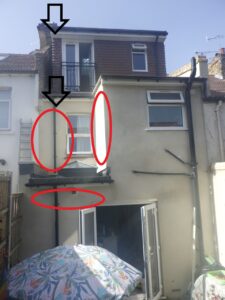
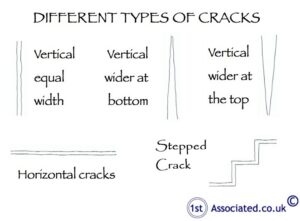
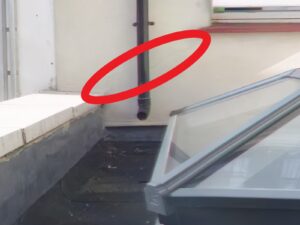
Meet your Building Surveyor
We always recommend that we meet you at the property during the survey and we are more than happy to talk about anything that we have found or discuss any questions you have with regard to extending or altering the property.
Please free phone 0800 298 5424 for a friendly chat with one of our surveyors or email info@1stAssociated.co.uk
Article that is over twenty years old
We originally wrote this article on spray foam over twenty years ago, we have revised this many times over the years. However, you can see within our article that we have decided to keep information that we put into the report in 2005/2006 from the Building Research Establishment (BRE) and information from the Glasgow Caledonian University in 2009. Probably the main thing that we noted when updating this version of our article is that when you google spray foam you now find there are a fair number of companies that remove spray foam which we had not come across in such numbers when we were doing research for previous articles.
House of Commons discussion 14th April 2023
Spray foam is one of those things that has now got an importance level when you find that it has been discussed in the House of Commons. We thought a good way to start this article would be to offer a few thoughts from those dealing with spray foam and as far as we are aware this discussion was in relation to spray foam insulation and mortgages.
Nationwide Building Society
We noticed the House of Commons discussed spray foam insulation and mortgages on 14th April 2023 and this article has links to the Nationwide Building Society. Robert Stevens, Director of Property Risk at the lender advised;
‘Spray foam insulation can be a good way to improve the energy efficiency of a home …. however if it is not installed in line with manufacturer’s recommendations then there is an inherent risk of causing damage to the roof structure which can lead to costly repair bills and the need for spray foam to be removed. Consequently, when a valuer, also known as a surveyor, sees evidence of spray foam we require documented evidence it has been installed correctly before we lend.’
We would say the difficulty is getting the evidence of it being installed correctly having requested such information when we have been carrying out building surveys on a property and have not as yet been provided with any evidence of how the spray foam has been installed and as such we have not been able to comment on it.
Zero tolerance from lenders
From what we understand the House of Commons researchers spoke to mortgage advisers who commented that there was zero tolerance regardless of how the work has been done:
Marcus Wright, Managing Director of Bolton Business Finance advised he had seen buy to let mortgages declined.
Dan Osman of UK Moneyman of Later Life Lending Company (often known by the generic term of equity release – we have added these words) said ‘For older folks looking to exploit equity release the spray foam loft insulation they have installed to make their homes more energy efficient is likely to result in immediate decline’.
Imran Hussain, Director of Harmony Financial Services advises that spray foam insulation gets a resounding no from quite a lot of lenders; when you have one of the largest lenders in the company warning about it then it should be taken seriously.
Lewis Shaw of Riverside Mortgages advises that very few mortgage lenders will consider properties with spray foam so in the most robust sense of the term ‘caveat emptor’ because it can be a very costly mistake.
Retracted advice
Residential Property Surveyors Association (RPSA) retracted their advice about spray foam in October 2022 originally stating that investigations failed to identify any circumstances at all where a roof with spray foam could be given a clean bill of health. Alan Milstein, the Chairman of Residential Property Surveyors Association (RPSA) advised they had retracted their current guidance and were carrying out a full review.
Residential Property Surveyors Association (RPSA) (note this is not the Royal Institution of Chartered Surveyors) and also the Property Care Association (PCA) a trade association originally established in the 1930’s as the British Wood Preserving Association BWP, it merged with the British Chemical Damp Proof Association BCDA in 1988 that association being formed in 1977. In 2003 the Property Care Association and Wood Protection Association was formed and they separated in 2006 into the PCA Property Care Association and Wood Protection Association WPA.
Information Taken from Property-Care.org website.
Royal Institution of Chartered Surveyors (RICS)
The RICS on the 3rd March 2023 issued a press release on spray foam under a new consumer guide which we are more than happy to forward a copy onto you. It is titled ‘Spray Foam Insulation – a clear impartial guide’ and is specifically about Spray Polyurethane Foam (SPF) and discusses how spray foam changes a cold roof into a warm roof and advises this doesn’t apply to new build structures although as far as we can see does not give dates. We think the colder / warm roof diagrams are very good. It also discusses the risk from spray foam insulation and how there are different types and how it is not easily reversible and how there are hidden problems such as damp and condensation that we discuss further in this article and how difficult it is to identify problems. It talks about the benefits of energy saving and also identifies the risk as Spray Polyurethane Foam is a combustible material and also discusses spray foam suitable for your home and the benefits of installing at ceiling level rather than on the underside of the pitch of the roof and gives a useful decision tree at the end. Unless we have missed something, we believe that it misses the most important thing about the mortgageability and therefore the saleability of a house although it does say to seek independent advice from a qualified and experienced adviser.
Which? – the UK’s consumer champion
There has also been a Which? article by Adam Snook which covers the topics of Spray foam insulation issues and What is spray foam insulation?, Is spray foam insulation safe?, Will spray foam insulation increase or decrease my house value?, Types of spray foam insulation divided into closed cell spray foam and open cell spray foam, Spray foam insulation costs, Why consider spray foam?, Can I install spray foam insulation myself? and ends with Finding an insulation installer.
We think it would be better if it ended with Find a Chartered Building Surveyor or similar qualified professional who can advise you whether it is appropriate for you as it can be a very costly mistake when you come to sell the property and a mortgage is no longer possible on the property and/or you wish to do some form of reversion which is excluded as well.
Spray foam insulation, has it ruined the house?
 We looked at a lovely house today where the people were obviously very house proud. The general care that they had taken in looking after the building was evident throughout, until we extended our ladder up into the loft space (we have one of these extendable ladders that can get almost anywhere which was a fantastic invention).
We looked at a lovely house today where the people were obviously very house proud. The general care that they had taken in looking after the building was evident throughout, until we extended our ladder up into the loft space (we have one of these extendable ladders that can get almost anywhere which was a fantastic invention).
The building survey/structural survey was going so well up to this point when we saw within the roof that spray foam insulation had been used.
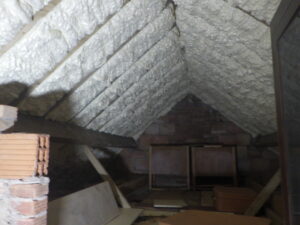
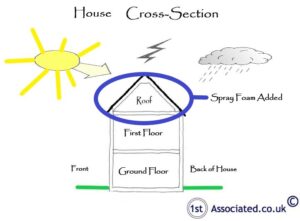
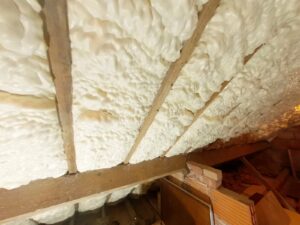
Spray Foam not recommended by most Surveyors
As we entered the roof we could see that the whole of the underside of the roof had been sprayed with spray foam insulation. If you haven't seen this before spray foam insulation is frequently advertised in newspapers and magazines and all over the internet. It looks a bit like a Crunchie bar without the chocolate or if you are a keen DIYer its very much like the expanding foam that you use to fill in gaps that's available from B&Q, Wickes or other similar good DIY places, that you spray in to fill any gaps or holes that you have when you have carried out work.
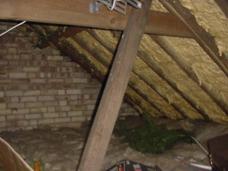
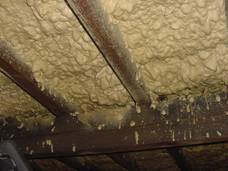
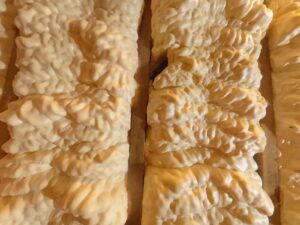
Spray foam - the benefits?
If you read the sales literature from the various spray foam companies they will say spray foam is used for several reasons:-
1) The spray on foam salesman's pitch goes something along the lines of that the spray foam stops tiles and slates from slipping and strengthens the roof by holding them in place.
2) Increases the insulation in a roof and protects water tanks and pipes from freezing.
3) It creates a dry, clean, useful loft space.
4) We have heard it claimed to be environmentally friendly.
5) It's quick
We think that these above claims are debatable at best and probably the last claim that it is quick, is a reason why most people use it as they have a fear with a roof leaking or in bad condition that;-
a) Tiles fall off and injure people passing the property or fall into the house and injure people within the property.
b) The roof will leak and damage goods inside as well as the property.
Googling for spray foam
There are lots of manufacturers who deal with the selling of spray foam. If you Google on the internet spray foam insulation for houses you will come across lots of manufacturers, these are a few that we found:-
Roofbond
EPS
Sprayseal
Spray Insulation Ltd
Foam Insulation
Isothane Ltd
As well as a number of DIY sites.
What is the spray foam?
The spray on foam is a rigid foam that is lightweight, normally sprayed on to the underside of the roof approximately 50 to 100 mm thickness.
1) Some manufacturers advise that the spray foam is breathable, some of them say nothing at all about this.
2) Many say it has a British Board of Agreement or BBA approval which means the same thing.
3) Some give guarantees for 25 years or so.
Everyone in the spray foam industry seems to be pushing the benefits of spray foam, however why do many independent surveyors still not like it or recommend it and many surveyors who are valuers will down value a property because it has the insulation.
We have heard that also the National Federation of Roofing Contractors doesn't recommend it. It could be argued that the National Federation of Roofing Contractors are losing out with this technology as it is a competing technology they are losing roof work, however independent surveyors have no reason to recommend it or not recommend it.
They still get paid for their reports either way. Read on to learn more about spray foam problems.
What are the problems with spray foam insulation?
The main argument against it for many years has been that any dampness getting in or condensation being caused, leading to rotting of roof trusses, battens and purlins.

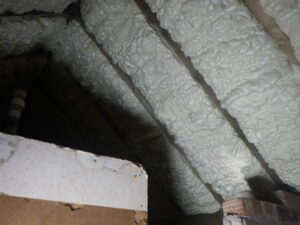
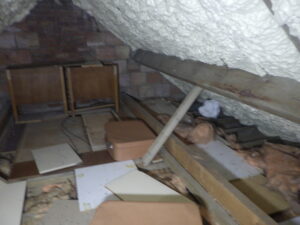
Common Rafters Defined:
The rafters are the timbers which form the slope to which the battens are secured, and in turn, the roof covering is also secured to them.
Purlins Defined:
Purlins are the horizontal cross members that give support to the common rafters.
This could cause problems in a manner of ways:
a) The rain from the outside can get in through a tile or slate that has become displaced (we know that they shouldn't become displaced once you have used this product but they do.)
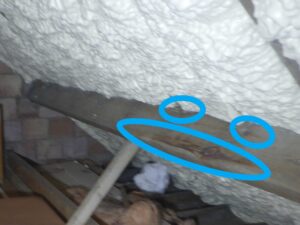
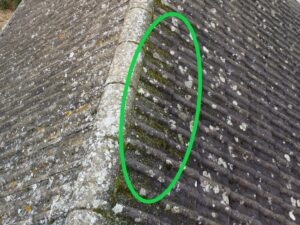
b) Probably the most important concern is that interstitial condensation occurs.
Interstitial Condensation Defined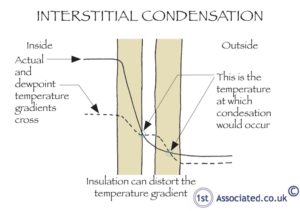
This is condensation within a material for example within a roof structure.
Interstitial Condensation is caused by there being a big difference in temperature between the inside and the outside and condensation occurring normally where the insulation meets the roof covering be it of tiles or slates. This condensation therefore then has nowhere to go but into the timber and in due course will cause rot. A roof breathes without spray on foam insulation to some extent and it also allows you to see where any dampness is coming in and repair it in this area.
Other products that say they repair roofs
We have seen a product called Stormflex that's says it does a better job at repairing tiles etc than spray on foam. We have not had experience of this so we can't comment on it.
Building Research Establishment Study on Spray Foam
The Building Research Establishment was a government owned body and is generally considered to be the main research establishment for new products and is commonly known by the name of BRE. If you are interested in visiting they have some buildings that can be walked around. In 2005/2006 studies by the Building Research Establishment and National Physics Labs found that the insulation levels of spray foam couldn't in the sample bring you values below 0.2 as are often claimed or our values of five to six tested in accordance with BS EN ISO 8990. There are values of 1.69 to 1.71 metres squared kilowatts as opposed to five or six. This is very embarrassing for many local authorities that have approved schemes based upon the industries figures. We would comment that you should never believe figures such as this that are industry produced without testing them by an independent basis such as the BRE.
British Standard and testing on Interstitial Condensation
The interstitial condensation is meant to be a problem with this type of foam insulated roofs however we couldn't find any evidence to prove this. The research British Standards did for BSI3788 which requires the taking of monthly values internally and externally and calculating whether there is any condensation on one or more surfaces. This is being done through the year in the winter and summer months. Research carried out by Glasgow Caledonian University 22 July 2009 concluded whilst fine film drops of condensation may be present during some of the time it wouldn't affect the roof timbers and therefore there is no grounds to rejecting insulating roofs on condensation risk. It makes us wonder whether it is more the fact that the water can get through the tiles and sit against the timber that causes future problems. It provides a satisfaction method of achieving the target insulation value of 0.16 watts per metre squared. This in turn doesn't relate back to the BRE's own research showing the products don't reach that thermal efficiency level unless the spray foam is very thick. We seem to recall that 130 mm was recommended.
Consensus of opinion on the internet
 If you Google spray foam insulation good or bad you will as well as getting the various companies that install it get a number of DIY websites that come up in the search results. Many of them comment to avoid it like the plague for a variety of reasons. Many talk about problems that they have had with not being able to repair their roof when it is leaking. We saw one article where it advised that they had had to reroof in the end and the roofer had said rather than being able to save 70 to75% of the slates they were only able to save 25% of them due to the foam damage, which greatly increased the cost.
If you Google spray foam insulation good or bad you will as well as getting the various companies that install it get a number of DIY websites that come up in the search results. Many of them comment to avoid it like the plague for a variety of reasons. Many talk about problems that they have had with not being able to repair their roof when it is leaking. We saw one article where it advised that they had had to reroof in the end and the roofer had said rather than being able to save 70 to75% of the slates they were only able to save 25% of them due to the foam damage, which greatly increased the cost.
Dampness is coming through my roof, spray foam is a quick way of fixing it?
If you are convinced that dampness is coming through your roof you need to take a second to consider is it really coming through your roof or is it condensation? As a surveyor we would comment that it may well be the second item condensation which you are suffering from.
We find that during the winter months we come across people that have what they believe to be dampness coming through their roof but it is in fact where the warm air from inside the property has arisen into the roof and met the coldness of the tiles or slates. Ironically this often occurs when hiding Christmas presents in the roof or getting Christmas decorations down from the roof or putting them back up in the roof. If you look at the various adverts for spray foam insulation it's very much sold as a quick fix where it is said that it can be fitted in one to two days. There is however the long term to consider as how do you fix roofs in years to come.
Never use spray foam on an old property that is Listed
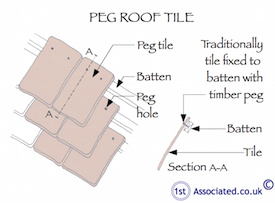 Older properties have a slightly different construction to modern properties. They often have handmade clay tile roofs that were originally fixed by an oak peg or slates that are nailed. In both cases dampness can get into the clay tiles for example by the tiles being displaced and to the slates by nail fatigue causing the nails to rust and displace. In both cases the quick fix of a spray on foam then looks a good way to resolve the problems, with the sales techniques being that is cures roof leaks, greatly improves insulation which is always a problem when you live in an older property as you suddenly realise how much heat is needed to keep it warm. We mentioned earlier that it can cut heat losses by down to 80% which is what the spray foam insulation sales people say and the big problem is when you have got a listed building and the spray foam insulation is used it damages something that simply cannot be replaced. Then you ultimately have to do a proper job on the roof and replace and repair the tiles, you will then find that as they are stuck to the foam insulation many of them are unusable.
Older properties have a slightly different construction to modern properties. They often have handmade clay tile roofs that were originally fixed by an oak peg or slates that are nailed. In both cases dampness can get into the clay tiles for example by the tiles being displaced and to the slates by nail fatigue causing the nails to rust and displace. In both cases the quick fix of a spray on foam then looks a good way to resolve the problems, with the sales techniques being that is cures roof leaks, greatly improves insulation which is always a problem when you live in an older property as you suddenly realise how much heat is needed to keep it warm. We mentioned earlier that it can cut heat losses by down to 80% which is what the spray foam insulation sales people say and the big problem is when you have got a listed building and the spray foam insulation is used it damages something that simply cannot be replaced. Then you ultimately have to do a proper job on the roof and replace and repair the tiles, you will then find that as they are stuck to the foam insulation many of them are unusable.
Independent Surveyors
If you truly want an independent expert opinion from a surveyor with regard to property problems, everything from roof leaks and cracks in buildings to dampness in buildings can be covered in our defects and engineers reports. We also look at whole buildings via our building surveys and structural surveys. Please free phone 0800 298 5424 for a friendly chat with one of our surveyors or email info@1stAssociated.co.uk
Commercial Property
If you have problems with your commercial property again we would be more than happy to help whether its freehold or leasehold. In addition if the property is leasehold we get involved in dilapidations claims and you may wish to look at our dilapidations website www.DilapsHelp.com and for disputes please got to our Disputes Help site at www.DisputesHelp.com .
We hope you found the article of use and if you have any experiences that you feel should be added to this article that would benefit others, or you feel that some of the information that we have put is wrong then please do not hesitate to contact us (we are only human).
The contents of the website are for general information only and are not intended to be relied upon for specific or general decisions. Appropriate independent professional advice should be paid for before making such a decision.
All rights are reserved the contents of the website are not to be reproduced or transmitted in any form in whole or part without the express written permission of www.1stAssociated.co.uk
Please see following articles which may be of interest to you:

